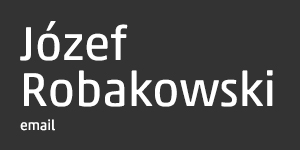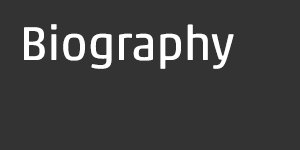Personal
Kata Krasznahorkai, „... I reject temporality”
Extended Cinema and Material Cinema, Grzegorz Borkowski talks
Extended Cinema and Material Cinema, Grzegorz Borkowski talks with Józef Robakowski
TRANZYSTOR CSWZU, nr 4—07.2012
What intrigued me in the ostensibly simple title of your exhibition, "My own cinema", was actually the word "cinema". What were your own fascinations with cinema before you started making your own movies? Have you continued any of them?
Imagine that I had an aunt that had her own cinema. Soon after war my mum with her two sons, I mean me and my brother, lived at this aunt's place, who also owned a big apartment building. The cinema was called "Warsaw" and was located at 36 Swietojanska street in Gdynia. It would have been hard not to go to a cinema, being a 6 year old. What was interesting, this cinema was set up in a pre-war way. My mum run a kiosk inside. I, a nonsmoker myself, was stealing cigarettes for my friends, mostly camels, as everything was coming from the West back then. Newspapers were sold in the kiosk in the evenings — it was the time when there were afternoon journals being published — and I took those papers from the kiosk and sold them to people in the hall. I was a newspaper boy. My aunt had a beautiful loge seating in this cinema, that was always empty, and me and my brother used to spend six or eight hours there sometimes, from the beginning 'til the end. Interestingly, there was a "Starting at 21" category. There were great American films being screened. Westerns, but also remember the historical ones from Italy. There were basically no Russian films after the war, they appeared after 1947 after this "Three Times Yes" People's Referendum. And I, as a DIYfascinated boy, found it very interesting that I could go to the projection cabin and get a piece of film stock from those guys… When the stock broke, they left me these little cuts. There were flammable and I made so called "stinks" out of them wrapped in newspaper. I also brought them to school with me in first grade and I was very happy that I had something nobody else had. Later I started building simple projectors: a light bulb in a box or can and a lens, but without the Maltese cross, so they could only move steadily, without variations as it is in a real projector.The same projector is exhibited here in the Ujazdowski Castle in the "Idle line" installation, with looped film stock.
I also made drawings to project them like slides, because I didn't have slides then. I could edit these cuts in the order I liked and glue the stock with my own hands. I was mostly interested in the operation on this machine and film. So it was material cinema, the projection itself, light, basically just like children' toys. There was no way a boy like me could make the mechanism of Maltese cross, that causes the jumping movement and makes the frame always get in the same spot. So it had to be a kind of smudgy projection, just like it is now at the exhibition. Oh, one more thing: there was no motor, the stock had to be winded manually, so you can say it was interactive.
Later, in 1947 or 1949, when I lived in Łódź already with a friend — I remember his name was Kozłowski, I was in the third grade — we've been building more elaborate projection cabins. You could already buy a set called "Young technician" and use the elements to create simple constructions.We organized small projections for your friends and we were very proud of it. This cinema can already be called my own. I still don't need any big technologies to make the construction of the installation interesting. For many people only professional cinema is important, you have to go to film school, be professional and go to Hollywood if possible. For me it's different — I was always fascinated by the mechanism, light, there could be images shown or not, only operating with light and shadow.
You've also made movies in an amateur film club…
Yes, in STKF Pętla in Torun, I think I made like 12 films there, a lot of them. The first one is projected in this exhibition under the title "6 million". The rest of them got lost somewhere in this club, they were experimental films and documentaries. This student production was also made on my own, I edited it myself in a very simple way. Film stock was glued manually, so it was very material work, I would sat. Thanks to that you knew very well how long each part is, you had it measured by your hands in a way. Pieces of stock were hanging on nails in the apartment, you were taking it and you saw that for example half a meter runs for about three seconds. You could feel it perfectly later. What is important is that stock, material, was treated as something extraordinary, it was very senseous. It's now called material cinema, there's a term like that in the experimental film. These fascinations resulted in holes I made directly in the stock when I was in film school. It was never done before in a professional film school, because school attracted only directors-writers or artists-cinematographers, who were interested only in the professional cinema. And there's no space for any experiments in there, it's full of technological regimes.
And what's interesting — despite the fact that I graduated from a professional film school and I made a couple professional films and a number of TV shows, I was always able to enter the level of material cinema, which thanks to it specific character has never existed in the professional production.
But you've seen many professional films…
After two years of living in Gdynia we moved with my mom and brother, first to Inowroclaw and then to Łódź, which has always fascinated me, because there was a largest number of cinemas in there. Warsaw had about 18 and Łódź wasn't destroyed during the war and had 24 cinemas from the pre-war times. I had my favorite cinema called Gdynia, not poshy at all, the ticket was 26 zlotys in 1949. I spent there all the money I got from my mother. We were already flooded by Russian cinema, American productions were banned completely, they were only allowing French and Italian ones. Sometimes these were their best historical movies, shown in complete sets. In 1951 we moved to a small town called Tuchola, where my mom became a teacher in an orphanage. There was one cinema called Mir. I remember I had a list of films I've seen in the 7th grade — 1300 titles. That's how many films I've written down, later I dropped the list, but I remember very well that it was still functioning in Tuchola in 1952, so it was really a totally maniac passion. Some of them I've seen many times, like the Soviet "Lonely White Sail". We obviously couldn't afford the tickets, we were boys from the orphanage, so we came up with the whole systems of entering this cinema. It was fascinating! The best trick was called "folded ticket" or we entered with the whole group earlier and hid under the platform, only to jump out during the screening of the film chronicle. It was such a passion that I couldn't control it. And since photography was related to the cinema, I was using the cameras that belonged to the photography club in the orphanage. My mom bought two or three cameras and I used them to take my first pictures.
You are one of the precursors of bringing the film in the space of contemporary art; how do you feel about using film by the artists, so popular these days? Are films presented in the galleries because there's no space for them in the cinemas and television? Or is it that the contemporary art spaces allow for more than cinemas and tv?
Cinemas could only screen what was in distriburion. My private films couldn't be in the national distribution. These kind of projections were suitable rather for galleries, that presented them as experimental or educational cinema. We were showing a lot of films about art from various embassies. These films could also be treated as a documentation of artistic events. I was using film in student galleries from the early times. In the experimental cinema you can take the camera away from the eye and allow for spontaneous recording, that would never be accepted in the mainstream cinema, because it was not used to it. However, in the gallery, as just a simply visual or sound-visual effect, it was very welcome.
We needed a new movement for that, the Expanded Cinema Movement. I knew this term already in 1970, from a book by Younglood, that was given to me by a student who bought it in New York as soon as it was published and offered it to me. I really liked it, because I do exactly the same cinema, transgressive not only in a technical way, but also mentally.
That's why I needed other places and spaces for this new cinema. It can be made with a home camera anytime, this camera can be with me day and night, I can record whenever I want to. Film-records are preserving temperament, mentality, historical events on film stock, so it's completely different than professional camera work, when you collaborate with a whole crew. I am able to combine professional and amateur work, although it is indeed difficult in the everyday life. When I was making a professional film, it always held up to the standards, my films about art are made this way. But now for example I am making a really big exhibition at Atlas Sztuki in Łódź and I am changing one of the gallery rooms into a typical cinema. It was the same way here at the Castle. We're actually showing films and video works in the rooms normally devoted to showing contemporary arts.
This exhibition at Atlas is supposed to be called "Eastern Front" and present the influences of everything that arrived in Poland after the revolution in Russia, especially to Łódź, because many avant-garde artists settled there. Strzemiński, Katarzyna Kobro, Karol Hiller came from Russia, in this super-interesting time; they actually conducted a desant to Poland and broght the new culture that has never functioned here before. I want to explicate their ideas of art with film screenings. We'll see whether this risky strategy will work. I think it will. I have the experience of the Workshop of the Film Form behind me, thathas entered the field of other media in a very evident way. These achievements have definitely helped to widen the field of the contemporary art and it should be remembered.
What, apart from being fascinated by Łódź avant-garde, made you different from the mainstream cinematography?
We all started to make films about art at the Workshop. I was an art history graduate and others were helped by a curator of the Museum of Art, Janusz Zagrodzki. He had open access to the museum materials. We started making real preparations for working at the Workshop by studying interwar avantgarde. We went through the whole legend of the avant-garde and made films about a.r., Witkacy, Strzemiński, Kobro, Szpakowski, Stażewski, Zofia Rydet. We were already artists, but we were also professionals, good craftsmen when it come to film and very often our workshop projections were accompanied by these films about art, they were suplemented by this avant-garde tradition. And this is this fantastic phenomena called Expanded Cinema; cinema as the emission of light — this theory was already being popularized by Karol Irzykowski in the 20's. He thought that cinema is a projection of light, that lights is the most important element in the cinema and light, not depiction of reality is its main function. Our studies were very much theory-based, which made us different from other filmakers who ignored it. We've had excellent teachers. After all, University of Łódź had a film studies department run by Bolesław Lewicki and a whole group of people working on theory. They were in touch with all the best fil theoreticians of that time. It was a different image and awareness of the cinema, understanding through theorypractice. We weren't impressed by the young filmakers at all, like Bajon or Kieślowski. The world of classic Polish film didn't exist for us. We caused a scandal in 1972 at a popular film festival for young filmakers in Gdańsk that was attended by everybody who wanted to know what will happen in the cinema. We were in our best condition then, some people from Cracow also arrived — Nyczek, Krynicki, Barańczak — the poets — we were friends with them, they were also dissenting. There were some late feature film debutants there — a film critic, KTT publicist and Jerzy Gruza with his "Woodpecker". We sat in various spots in the big room in Żak and we organized various pranks with the audience during the projection — talking, whistling, roaring or some stupid comments. Then the lights went on and it was a total embarassment, because the whole audience was really into those pranks. And we pretended to be boys from the dockyards, wearing some donkey jackets and saying some random stuff — that the film was shitty, some Polish paranoia, exclusive comedy. But on the side some guys were telling the debutants that we're from the film school, that they need to be careful because we dissent everything. We pushed this KTT "master" who manpiulated our culture in the communist Poland. He was everywhere, even in Jaruzelski's era. We didn't need this "professional" cinema back then. I remember the pre-release screening of my film about Katarzyna Kobro in 1971, it was one of the guests that told me: "Mr. Józef, you created some kind of hoax that this Kobro is some oustanding artist, she's just a normal wife of Strzemiński. We have to change your commentary, we can't just waste words like that". After that I knew that I'm dealing with people who only pretend to have any professional knowledge. They were usually journalists and people from the ministry: "Average viewer will never understand something like that...". There finally came a moment, about 1975, when we had to say goodbye to all this socialist cinematography. For us, people from the Workshop, all that was left was Extended Cinema, made entirely by ourselves. And it turned out, as we see today, to be our final victory.







